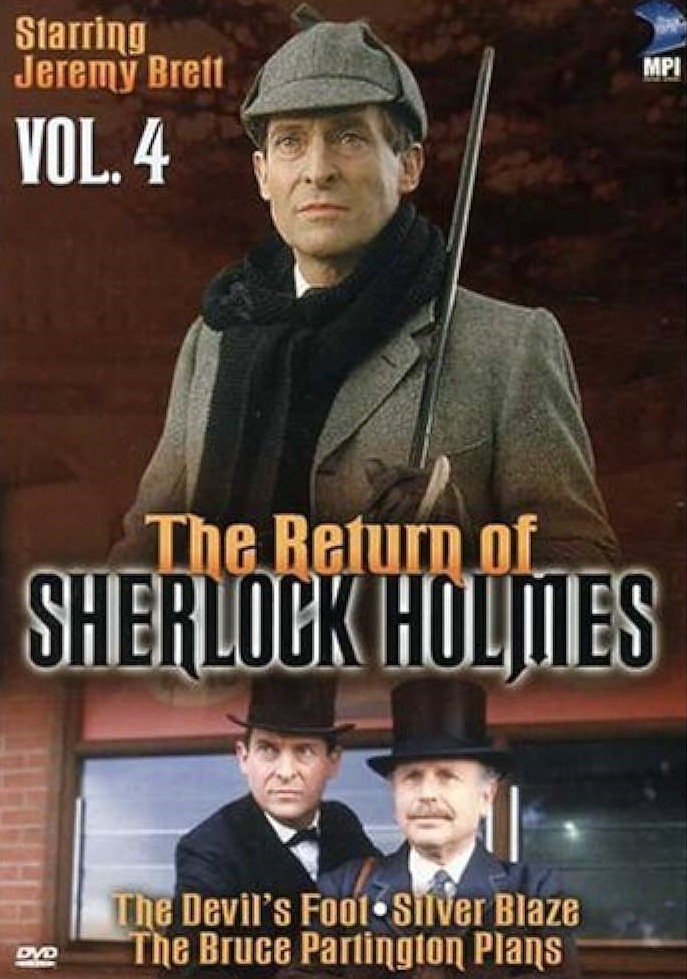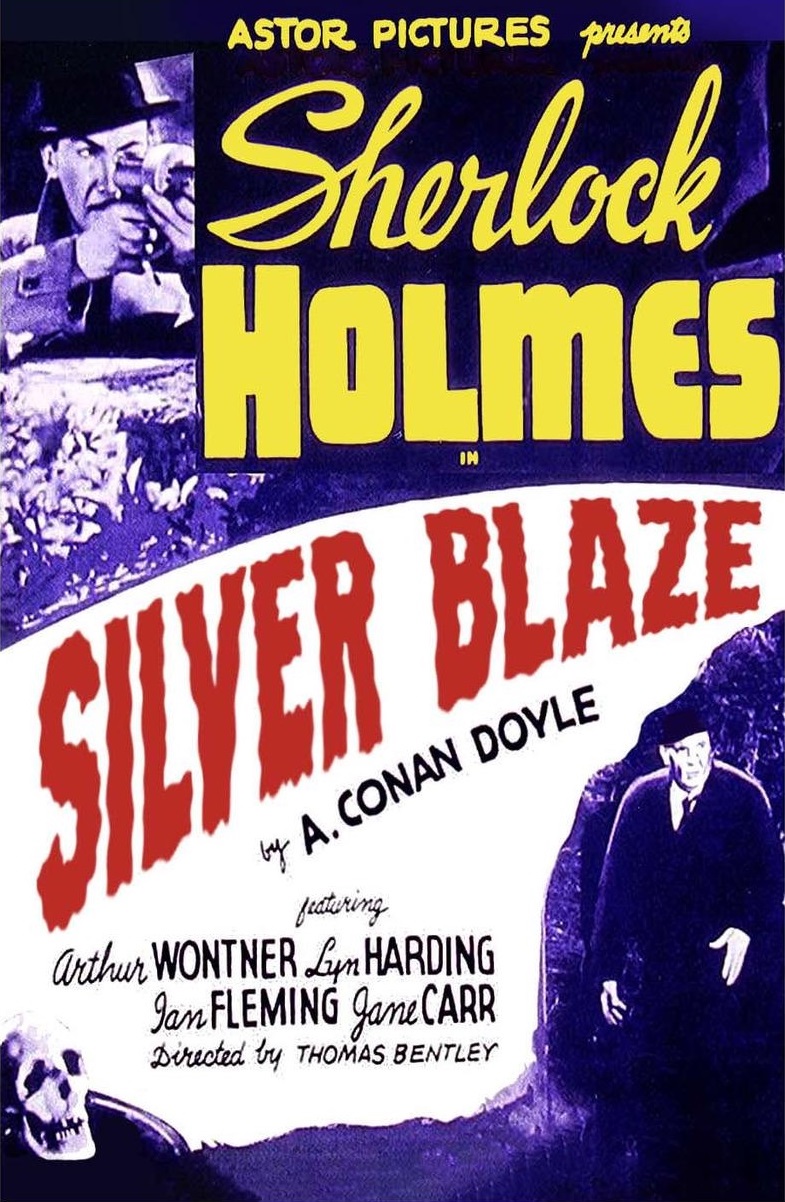
Our film correspondent bends his own rules to include a superb television adaptation of how the most famous fictional detective in history entered the world of horse racing
 Silver Blaze (1988)
Silver Blaze (1988)
directed by Brian Mills; starring Jeremy Brett and Edward Hardwicke
How’s this for a bet with the gang at the bar? Identify the most famous horse in literary fiction. Here’s my fiver, on the counter. Black Beauty, you say? The Black Stallion? How about Shadowfax, Artax, or that war horse named Joey?
Hard to argue with any of those mythical steeds. But for my money, the answer comes attached to a story featuring one of the most popular fictional characters in the English language. That would be Sherlock Holmes, consulting detective, of 221b Baker Street, London, England.
Silver Blaze – the name of the story and the horse – was published in Strand Magazine in December of 1892 and later collected among a dozen Arthur Conan Doyle mysteries in The Memoirs of Sherlock Holmes.
In their time, Holmes collections outsold every book this side of the Bible, and the character was an immediate hit on the theatrical stages of the late 1800s. Then, when movies caught fire at the dawn of the 20th century, versions of Sherlock Holmes were brought to the silver screen more often than Moses, Lincoln, and Elizabeth Rex combined.
With its built-in familiarity as part of the Holmes canon and its horse racing hook, Silver Blaze became popular source mat erial for the new motion picture craze.
erial for the new motion picture craze.
The first known adaptation was a two-reeler from 1912 as part of a series of Holmes mysteries produced by Britain’s Eclair Films and starring noted French actor Georges Treville, who also directed.
In 1923, Silver Blaze appeared again on screen as one of a dozen Holmes titles cranked out like weekly network TV shows by George Ridgwell, credited among the fathers of the British film industry.
First feature
For the purposes of this series, which already has loosened its rules, the first full-length feature version of Silver Blaze was released in 1937. The detective was played by Arthur Wontner, a respected British thespian who got the job on the strength of his stage performance as a knock-off Holmes called Sexton Blake.
Wontner interpreted a version of Homes so convincingly that Lady Jean Conan Doyle, widow of the author, sent him a fan letter praising Wontner’s “really splendid acting and masterly personification of Sherlock Holmes.”
Too bad Wontner’s Silver Blaze was such a dud. Cheaply mounted by Twickenham Studios (much later the home of films like Alfie and Blade Runner), the creators had no apparent faith in the central story of the kidnapped horse and the suspicious death of his trainer. 
Arthur Wontner as Holmes shares an observation with John Turnbull's baffled Inspector Lestrade in the 1937 version of Silver Blaze. (Astor Pictures photo)
From deep left field, they inserted plot lines involving characters from other Holmes stories, such as Henry Baskerville, he of the infamous hound, and Professor Moriarty, Sherlock’s arch-enemy.
Thus bloated, the work of Holmes in fathoming the essential mystery of the missing racehorse and dead trainer is lost. In 1941, the film was circulated in the US under the market-tested title, Murder at the Baskervilles. In fact, it was neither.
A more straightforward telling of Silver Blaze popped up on television in 1977, courtesy of an Anglo-Canadian anthology called Classics Dark and Dangerous. Christopher Plummer is a fine Holmes, although Christopher Plummer can do just about
Christopher Plummer strikes a contemplative pose as Holmes in the 1977 TV production of Silver Blaze. (Harlech Television and TVOntario photo)
anything, including sing ‘Edelweiss’.At just 30 minutes, the show hews closely to the printed page. The racing scene involving Silver Blaze is perfunctory and a bit silly, staged at a gentle gallop with what looks to be gentlemen jockeys. But Plummer is in juicy, condescending form, especially in his teasing reveal of the mystery’s particulars.
Clearly, it is not a spoiler to note that Silver Blaze was found and made it to his appointed race.
Ultimate interpreter
As to the identity of the trainer’s killer, for those not familiar with the story please go first to the text – a brisk 9,500 words – then turn immediately to the Granada Television version of Silver Blaze, a highlight of the exhaustive franchise fashioned by writer John Hawkesworth and starring Jeremy Brett as the ultimate interpreter of Sherlock Holmes.
Plummer's Holmes reveals the mystery of Silver Blaze to an astounded audience. (Harlech Television and TVOntario photo)
Brett was a classically-trained British actor who had been bouncing between stage and screen in entertainments as diverse as The Merchant of Venice at the Old Vic with Laurence Olivier, the film version of My Fair Lady opposite Audrey Hepburn, and an episode of The Incredible Hulk on US television, alongside Loni Anderson.
Brett also played Dr. Watson to Charlton Heston’s Holmes on stage in a Los Angeles production of The Crucifer of Blood, in 1980. The Granada series commenced in 1984, after which Brett gave over his career – and the rest of his life – to the embodiment of the detective. He died in 1995, at 59.
Acerbic, morose, manic and compassionate
Granada’s deep dive allowed Brett to craft a Sherlock Holmes like no other. Acerbic, morose, manic and compassionate by turns, over 41 episodes the actor was able to parcel out bits and pieces of both the intellectual and physical sides of the character, as James Jeffrey notes in The Critic:
“Brett brought great passion to the role, infusing his version of Holmes with the likes of eccentric hand gestures, barking out a short violent laugh, and a habit of suddenly throwing his napkin on the breakfast table before the meal has even commenced and rushing out the room, leaving a stricken – and hungry-looking – Watson in his wake, or plunging to the ground as if about to do a set of press-ups to get a better look at a footprint, somersaulting over furniture in the middle of a genteel room to make an urgent inspection, or jumping onto the parapet of a bridge to get a better understanding of where the villain might have flung a murderous weapon.”

Jeremy Brett's Holmes up close and personal with Silver Blaze. (Granada TV photo)
By the time the fourth season arrived, the Granada series had seduced the most skeptical Holmes scholars with its rich Victorian detail and fervent loyalty to the original texts.Silver Blaze, which first aired on April 13, 1988, affords Brett the opportunity to deploy all of the Holmes arsenal – observation, deduction, imagination – plus a mischievous spot of payback aimed at the imperious owner of Silver Blaze, a colt described as a son of the outstanding, real-life stallion Isonomy.
Incorrect assumptions must be skewered and authority questioned. The curry holds a clue, as well as lame lambs and a dog that does not bark. Jeremy Brett and Edward Hardwicke made a formidable team as Holmes and Watson. (Granada TV photo)
For the racing-wise reader, there will be obvious qualms about the sudden reappearance of the missing horse when his supposed abduction was so widely covered in the press. The obligatory race sets the stage for the reveal of the killer, after which Holmes and Watson share a lively dialogue in a post mortem to the case which deflates the arrogant owner at every turn. The film ends with a toast … to Silver Blaze.
The Granada production of Silver Blaze is available in a clean and clear HD remastering on YouTube
• View all Jay Hovdey’s features in his Favorite Racehorses series
‘A high-calorie feast of delightful excess’ – Jay Hovdey on Kincsem biopic
Horse racing at the movies: Phar Lap – how a Melbourne Cup icon became a hero of the silver screen
View the latest TRC Global Rankings for horses / jockeys / trainers / sires


